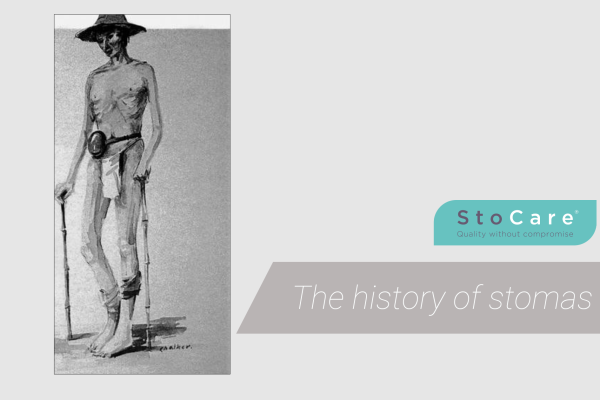According to Colostomy UK, up to 70% of ostomates will experience a parastomal hernia at some point. This common stoma problem can be alarming and cause further health complications, but they are often nothing to worry about. But what is a parastomal hernia, what causes them and how can you prevent it from happening to you? In this guide, we will answer all of your parastoma hernia-related questions.
What is a parastomal hernia?
A hernia is when an organ pushes through a weak spot in the muscle.
When a stoma is formed, a surgeon creates a small incision in the abdominal muscles for an end of the intestine to be pulled through. This should be a snug fit and the abdominal muscles normally provide support for the stoma.
However, surgery can weaken the muscle, making it susceptible to a parastomal hernia. This term describes when a section of the intestine, fat, or other abdominal tissue pushes through the muscle in the same area as the stoma and presses against the skin. This is usually because the edge of the stoma has come away from the abdominal muscle.
This results in swelling around the stoma, which can gradually get bigger over time. You can get a hernia after stoma reversal surgery.

How do I know if I have a parastomal hernia?
So what are the symptoms of a parastomal hernia? You may experience swelling or bulging around or underneath your stoma. It may look like a golf ball-sized lump, but it can be much bigger. Your stoma may change in size or shape, and you may find it difficult to get your usual stoma bag to fit. This can cause leakage problems.
You may also experience some pain or discomfort around your stoma, especially when you cough, sneeze or lift things. A stoma hernia can also make your stoma behave differently, for example causing constipation and/or diarrhoea.
However, not all hernias have symptoms.

What causes a parastomal hernia?
Parastomal hernias are most likely to happen within the first one to two years after stoma surgery, when your abdominal muscle has not had the chance to fully regain its strength (but they can occur at any time).
Some of the other risk factors that can contribute to the development of a stoma hernia are:
- Being overweight
- Abdominal muscles weakening with age or lack of exercise
- Heavy lifting or other strenuous activity
- Coughing or sneezing
- Infection at the site of the stoma
- Poor stoma siting
- Emergency surgery
Some people are also more prone to hernias because of a genetic inability to produce collagen, meaning their muscles struggle to repair and strengthen.
In addition, people who are malnourished, smoke or use corticosteroids can lose their ability to produce collagen, making them more vulnerable to hernias.
How to prevent a parastomal hernia
If you have recently had stoma surgery (within the last 3 months), it’s important to listen to your stoma care specialist in regards to when you should resume physical activity. Your abdominal muscles are weaker so avoid heavy lifting and support your abdomen when you cough or sneeze. Try these gentle home exercises as recommended by Colostomy UK to gradually build your abdominal strength.
Once you have recovered from surgery, exercise regularly and maintain a healthy diet to reduce the chance of weight gain which can cause parastomal hernias. You should still avoid heavy lifting where possible, but you can wear a support garment if you partake in strenuous activities regularly (such as during sport or at work). These are worn around the abdomen to secure the stoma in place while supporting the muscles.
Is a parastomal hernia dangerous?
Parastomal hernias rarely cause complications and most people can continue to live as normal with one.
Although they aren’t usually an emergency, you should contact your stoma nurse if you suspect you have an ostomy hernia, especially if you are experiencing pain. They will assess how serious your parastomal hernia is and give you advice on how to manage it. They may suggest that you use a different type of stoma bag, cut your baseplate larger or wear a support garment.
In rare cases, stoma hernias can trap the bowel, resulting in obstruction or strangulation which is very dangerous. This requires emergency surgery. Read more: Stoma blockage
Parastomal hernia treatment
So how do you get rid of a parastomal hernia? Most of the time, they won’t require surgery. Wearing a support garment (such as a belt, pants, shorts, girdles, etc) will help and you may be able to get them on prescription. Your stoma nurse will recommend the best option for you. They will also recommend products that will help you to secure your stoma bag around the hernia such as stoma seals; we recommend the Ostoform FLOWASSIST because it has a unique split ring which can fit around stomas of any size or shape.
The skin around your stoma may feel tight because it is being stretched, making it more vulnerable to damage when removing and applying stoma bags. To mitigate this, you can use medical adhesive remover to gently remove appliances from the skin and barrier films to protect the skin between changes. Find out more: Peristomal skin protection
If your stoma hernia is very painful, is becoming so large that it is unmanageable or has caused a complication such as strangulation or obstruction, surgery to repair the hernia may be considered. Your doctor may consider a tissue repair (but there is a high chance of the hernia recurring), repairing the hernia with mesh, or in rare cases, resiting your stoma. This is highly dependable on your health and your doctor will discuss all the options with you.
Frequently asked questions about parastomal hernias
No, a stoma prolapse is not the same as a stoma hernia. In a parastomal hernia, the bowel pushes past an area of weak muscle and bulges against the skin. With a stoma prolapse, the bowel pushes through the stoma itself and protrudes out of the body.
Yes, parastomal hernias can get gradually bigger over time.
Parastomal hernias can cause stoma blockages which, if left untreated, can cause a ruptured bowel. Contact your GP or stoma care nurse if you suspect your stoma is blocked. Find out the symptoms in this article: Stoma blockage
Parastomal hernias are often nothing to worry about, but you should inform your stoma care specialist or GP if you suspect you have one. They will give you advice on how to ensure it does not get worse. Don’t delay in seeking medical advice if you are experiencing pain as this could be a sign of a more serious problem.
Hernias do not go away by themselves, but often they do not get worse over time and can be effectively managed without affecting your quality of life.
Stoma resources
Dealing with a stoma hernia can feel overwhelming at times, but with the right knowledge and resources, problems associated with ostomy hernias can be managed or prevented.
Whatever you’re going through on your stoma journey, remember help is always available. You are not alone and there is a large community of ostomates who understand what you are going through. You can connect with them and find support from these resources:
Ileostomy and Internal Pouch Association
If you are a medical professional and are interested in finding out how StoCare products can help your patients or requesting a repeat sample order, please email info@rhodespharma.co.uk.
Although all our articles are written alongside qualified medical professionals, this information is for guidance only and does not replace advice given by your healthcare advisors.





